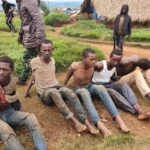The highly anticipated Alaska summit between US President Donald Trump and Russian President Vladimir Putin took place Friday, drawing global attention as the future of Ukraine hung in the balance.
Donald Trump entered the talks publicly optimistic about reaching a deal to halt Russia’s war in Ukraine. “I believe now he’s convinced that he’s going to make a deal. He’s going to make a deal. I think he’s going to. And we’re going to find out, I’m going to know very quickly,” Trump said during a Fox News Radio appearance.
However, Trump tempered expectations, calling the summit “setting the table for the second meeting,” which he envisions including Ukrainian President Volodymyr Zelenskyy and possibly European leaders. “We are going to have the second meeting if the first one goes well,” he added.
While Trump emphasized his goal of a ceasefire, Kremlin officials signaled a different agenda. Kremlin spokesperson Dmitry Peskov confirmed that no formal documents were expected to be signed.
📰 Also Read This:
“President Putin and President Trump are ready to talk and will discuss the most difficult issues,” Peskov said, highlighting Moscow’s intent to project strength rather than immediately negotiate peace.
Putin’s aide Yuri Ushakov described the talks as focusing on the “settlement” of Russia’s war in Ukraine, economic cooperation, and global security. Putin himself stressed the summit’s importance for long-term conditions of peace between the US, Russia, Europe, and the world, without specifically mentioning steps to end the war.
Analysts from the US-based Institute for the Study of War noted that Moscow is likely using the Alaska summit to present Putin as an equal to Trump on the global stage, rather than as a forum for urgent ceasefire negotiations. Russian negotiator Kirill Dmitriev drew historical comparisons, referencing the 1945 Yalta Conference, suggesting that Putin and Trump could prevent a “World War III” through their talks.
Trump rejected the notion that the summit could be seen as a reward for Putin. He insisted that his presence serves to ensure accountability, stating, “Without me he would take over all of Ukraine. But I am president and he is not going to mess with me.”
Ukraine’s leadership, meanwhile, sought to influence the summit despite not being present. President Zelenskyy and European partners held a virtual summit days prior, emphasizing that “nothing about Ukraine without Ukraine.”
Zelenskyy stressed the urgent need for a ceasefire, adding, “President Trump said this is one of his priorities in conversation with President Putin.”
Germany’s Chancellor Friedrich Merz underscored the importance of sequence in negotiations: first a ceasefire, then a framework agreement, and finally potential discussions on territorial issues. He reiterated that Ukraine must have a seat at the table if substantive progress is to be made.
Trump has expressed frustration over Russia’s ongoing attacks on civilians, warning of “severe consequences” if the Alaska summit does not influence Moscow’s military decisions. Yet he acknowledged the limits of his influence: “I guess the answer to that is no, because I’ve had this conversation (with Putin).”
The summit was held at the US Air Force’s Joint Base Elmendorf-Richardson in Anchorage, beginning with a one-on-one discussion at 9:30 pm CEST, followed by a working breakfast. Talks then continued in a broader format with delegations from both nations.
Russia’s delegation included top officials such as Foreign Minister Sergey Lavrov, Defence Minister Andrei Belousov, Finance Minister Anton Siluanov, and Kirill Dmitriev. Notably absent was Vladimir Medinsky, who previously led Russia’s direct talks with Ukraine, signaling Moscow’s limited willingness for direct dialogue with Kyiv.
Trump described the Alaska summit as a precursor to a second, more consequential meeting with Zelenskyy, potentially involving European leaders. The US president suggested that this follow-up could be bilateral or trilateral, depending on Ukraine’s participation.
Ushakov highlighted the symbolic location of the summit, “near the graves of Soviet pilots in Alaska,” while Ukraine’s Centre for Countering Disinformation warned that Russia may bring pseudo-historical materials, including maps suggesting Ukraine is an “artificial state.”
Zelenskyy, after a call with Trump and European leaders, stressed that Putin is “bluffing” about sanctions’ effectiveness, emphasizing that the Russian president’s ultimate goal remains the occupation of Ukraine. European leaders, including France’s Emmanuel Macron, echoed the need for Ukraine’s inclusion in any follow-up talks.
Despite the high stakes, expectations remained measured. Trump repeatedly downplayed the immediate outcomes of the Alaska meeting, framing it as a strategic step toward a more meaningful negotiation with Zelenskyy.
Analysts say the summit reflects a larger geopolitical chessboard, with Trump seeking to negotiate peace, Putin aiming for prestige, and Europe and Ukraine pushing for tangible actions to end the war.
As global attention focuses on Alaska, the summit could either mark the beginning of serious diplomatic progress or another display of political theater. For Ukraine, the world is watching, and the stakes could not be higher.







